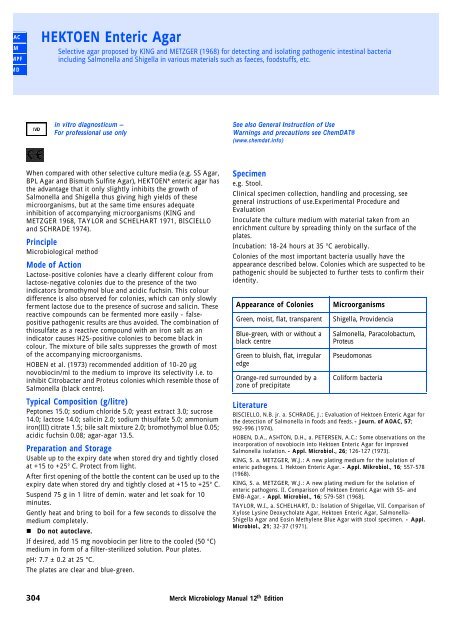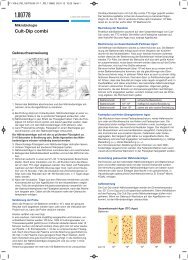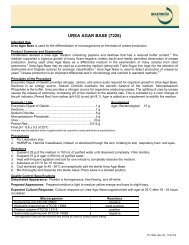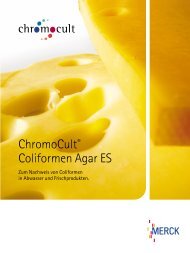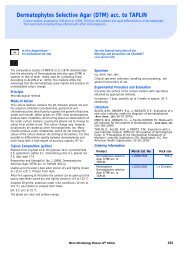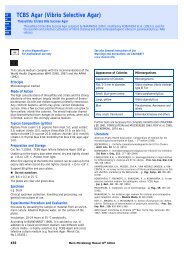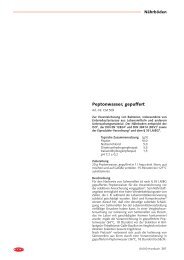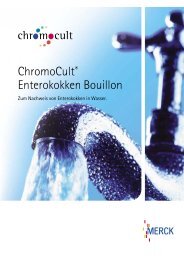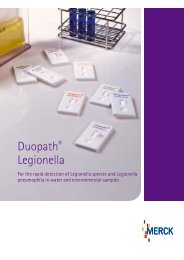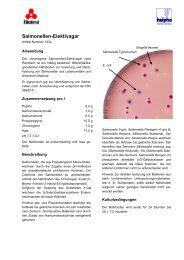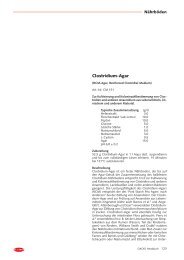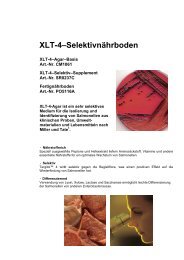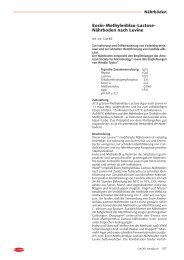HEKTOEN Enteric Agar - mibius
HEKTOEN Enteric Agar - mibius
HEKTOEN Enteric Agar - mibius
Create successful ePaper yourself
Turn your PDF publications into a flip-book with our unique Google optimized e-Paper software.
AOAC<br />
BAM<br />
COMPF<br />
SMD<br />
<strong>HEKTOEN</strong> <strong>Enteric</strong> <strong>Agar</strong><br />
Selective agar proposed by KING and METZGER (1968) for detecting and isolating pathogenic intestinal bacteria<br />
including Salmonella and Shigella in various materials such as faeces, foodstuffs, etc.<br />
<strong>HEKTOEN</strong> <strong>Enteric</strong> <strong>Agar</strong><br />
in vitro diagnosticum –<br />
For professional use only<br />
See also General Instruction of Use<br />
Warnings and precautions see ChemDAT®<br />
(www.chemdat.info)<br />
When compared with other selective culture media (e.g. SS <strong>Agar</strong>,<br />
BPL <strong>Agar</strong> and Bismuth Sulfite <strong>Agar</strong>), <strong>HEKTOEN</strong>* enteric agar has<br />
the advantage that it only slightly inhibits the growth of<br />
Salmonella and Shigella thus giving high yields of these<br />
microorganisms, but at the same time ensures adequate<br />
inhibition of accompanying microorganisms (KING and<br />
METZGER 1968, TAYLOR and SCHELHART 1971, BISCIELLO<br />
and SCHRADE 1974).<br />
Principle<br />
Microbiological method<br />
Mode of Action<br />
Lactose-positive colonies have a clearly different colour from<br />
lactose-negative colonies due to the presence of the two<br />
indicators bromothymol blue and acidic fuchsin. This colour<br />
difference is also observed for colonies, which can only slowly<br />
ferment lactose due to the presence of sucrose and salicin. These<br />
reactive compounds can be fermented more easily - falsepositive<br />
pathogenic results are thus avoided. The combination of<br />
thiosulfate as a reactive compound with an iron salt as an<br />
indicator causes H2S-positive colonies to become black in<br />
colour. The mixture of bile salts suppresses the growth of most<br />
of the accompanying microorganisms.<br />
HOBEN et al. (1973) recommended addition of 10-20 µg<br />
novobiocin/ml to the medium to improve its selectivity i.e. to<br />
inhibit Citrobacter and Proteus colonies which resemble those of<br />
Salmonella (black centre).<br />
Typical Composition (g/litre)<br />
Peptones 15.0; sodium chloride 5.0; yeast extract 3.0; sucrose<br />
14.0; lactose 14.0; salicin 2.0; sodium thisulfate 5.0; ammonium<br />
iron(III) citrate 1.5; bile salt mixture 2.0; bromothymol blue 0.05;<br />
acidic fuchsin 0.08; agar-agar 13.5.<br />
Preparation and Storage<br />
Usable up to the expiry date when stored dry and tightly closed<br />
at +15 to +25° C. Protect from light.<br />
After first opening of the bottle the content can be used up to the<br />
expiry date when stored dry and tightly closed at +15 to +25° C.<br />
Suspend 75 g in 1 litre of demin. water and let soak for 10<br />
minutes.<br />
Gently heat and bring to boil for a few seconds to dissolve the<br />
medium completely.<br />
• Do not autoclave.<br />
If desired, add 15 mg novobiocin per litre to the cooled (50 °C)<br />
medium in form of a filter-sterilized solution. Pour plates.<br />
pH: 7.7 ± 0.2 at 25 °C.<br />
The plates are clear and blue-green.<br />
Specimen<br />
e.g. Stool.<br />
Clinical specimen collection, handling and processing, see<br />
general instructions of use.Experimental Procedure and<br />
Evaluation<br />
Inoculate the culture medium with material taken from an<br />
enrichment culture by spreading thinly on the surface of the<br />
plates.<br />
Incubation: 18-24 hours at 35 °C aerobically.<br />
Colonies of the most important bacteria usually have the<br />
appearance described below. Colonies which are suspected to be<br />
pathogenic should be subjected to further tests to confirm their<br />
identity.<br />
Appearance of Colonies<br />
Green, moist, flat, transparent<br />
Blue-green, with or without a<br />
black centre<br />
Green to bluish, flat, irregular<br />
edge<br />
Orange-red surrounded by a<br />
zone of precipitate<br />
Microorganisms<br />
Shigella, Providencia<br />
Salmonella, Paracolobactum,<br />
Proteus<br />
Pseudomonas<br />
Coliform bacteria<br />
Literature<br />
BISCIELLO, N.B. jr. a. SCHRADE, J.: Evaluation of Hektoen <strong>Enteric</strong> <strong>Agar</strong> for<br />
the detection of Salmonella in foods and feeds. - Journ. of AOAC, 57;<br />
992-996 (1974).<br />
HOBEN, D.A., ASHTON, D.H., a. PETERSEN, A.C.: Some observations on the<br />
incorporation of novobiocin into Hektoen <strong>Enteric</strong> <strong>Agar</strong> for improved<br />
Salmonella isolation. - Appl. Microbiol., 26; 126-127 (1973).<br />
KING, S. a. METZGER, W.J.: A new plating medium for the isolation of<br />
enteric pathogens. I. Hektoen <strong>Enteric</strong> <strong>Agar</strong>. - Appl. Mikrobiol., 16; 557-578<br />
(1968).<br />
KING, S. a. METZGER, W.J.: A new plating medium for the isolation of<br />
enteric pathogens. II. Comparison of Hektoen <strong>Enteric</strong> <strong>Agar</strong> with SS- and<br />
EMB-<strong>Agar</strong>. - Appl. Microbiol., 16; 579-581 (1968).<br />
TAYLOR, W.I., a. SCHELHART, D.: Isolation of Shigellae, VII. Comparison of<br />
Xylose Lysine Deoxycholate <strong>Agar</strong>, Hektoen <strong>Enteric</strong> <strong>Agar</strong>, Salmonella-<br />
Shigella <strong>Agar</strong> and Eosin Methylene Blue <strong>Agar</strong> with stool specimen. - Appl.<br />
Microbiol., 21; 32-37 (1971).<br />
304 Merck Microbiology Manual 12 th Edition
<strong>HEKTOEN</strong> <strong>Enteric</strong> <strong>Agar</strong><br />
Ordering Information<br />
Product Merck Cat. No. Pack size<br />
<strong>HEKTOEN</strong> <strong>Enteric</strong> <strong>Agar</strong> 1.11681.0500 500 g<br />
Novobiocin monosodium<br />
salt<br />
CN Biosciences<br />
* Hektoen Institute for Medical Research, Chicago, USA<br />
Quality control (spiral plating method)<br />
Test strains<br />
Inoculum<br />
(cfu/ml)<br />
Rovery rate<br />
(%)<br />
Colour<br />
Colonies Black<br />
centre<br />
Escherichia coli ATCC 25922 < 10 5 Not limited orange-red - ±<br />
Enterobacter cloacae ATCC 13047 10 3 -10 5 ≥ 30 orange-red - ±<br />
Klebsiella pneumoniae ATCC 13883 10 3 -10 5 ≥ 30 orange-red - +<br />
Salmonella typhimurium<br />
ATCC 14028<br />
Recipitate<br />
10 3 -10 5 ≥ 20 blue-green + -<br />
Salmonella enteritidis ATCC 13076 10 3 -10 5 ≥ 20 blue-green + -<br />
Shigella flexneri ATCC 12022 10 3 -10 5 ≥ 5 green to<br />
blue-green<br />
Shigella sonnei ATCC 11060 10 3 -10 5 ≥ 20 green to<br />
blue-green<br />
Proteus mirabilis ATCC 14273 10 3 -10 5 ≥ 30 green to<br />
blue-green<br />
Enterococcus faecalis ATCC 11700 > 10 5 ≤ 0.01<br />
Staphylococcus aureus ATCC 25923 > 10 5 ≤ 0.01<br />
- -<br />
- -<br />
± -<br />
Yersinia enterocolitica ATCC 9610 10 3 -10 5 ≥ 30 orange-yellow - ±<br />
Proteus mirabilis<br />
ATCC 14273<br />
Salmonella enteritidis<br />
ATCC13076<br />
Merck Microbiology Manual 12 th Edition 305


